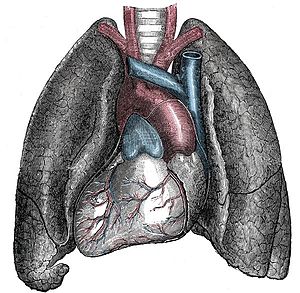Situs Inversus
| Situs inversus | |
|---|---|
 |
|
| Situs inversus causes the positions of the heart and lungs to be mirrored. | |
| Classification and external resources | |
| Specialty | Medical genetics |
| ICD-10 | Q89.3 |
| ICD-9-CM | 759.3 |
| OMIM | 270100 |
| DiseasesDB | 29885 |
| eMedicine | radio/639 |
| MeSH | D012857 |
Situs inversus (also called situs transversus or oppositus) is a congenital condition in which the major visceral organs are reversed or mirrored from their normal positions. The normal arrangement of internal organs is known as situs solitus while situs inversus is generally the mirror image of situs solitus. Although cardiac problems are more common than in the general population, most people with situs inversus have no medical symptoms or complications resulting from the condition, and until the advent of modern medicine it was usually undiagnosed.
Situs inversus is found in about 0.01% of the population, or about 1 person in 10,000. In the most common situation, situs inversus totalis, it involves complete transposition (right to left reversal) of all of the abdominal organs. The heart is not in its usual position in the left chest, but is on the right, a condition known as dextrocardia (literally, right-hearted). Because the relationship between the organs is not changed, most people with situs inversus have no medical symptoms or complications, although they should wear a medical identification tag to warn emergency medical staff that the patient's internal organs are reversed from normal so they can act accordingly, e.g. by listening for a heartbeat on the right rather than left side of the chest.
In rarer cases such as situs ambiguus or heterotaxy, situs cannot be determined. In these patients, the liver may be midline, the spleen absent or multiple, and the bowel malrotated. Often, structures are duplicated or absent altogether. This is more likely to cause medical problems than situs inversus totalis.
In the absence of congenital heart defects, individuals with situs inversus are phenotypically normal, and can live normal healthy lives, without any complications related to their medical condition. There is a 5–10% prevalence of congenital heart disease in individuals with situs inversus totalis, most commonly transposition of the great vessels. The incidence of congenital heart disease is 95% in situs inversus with levocardia.
...
Wikipedia
